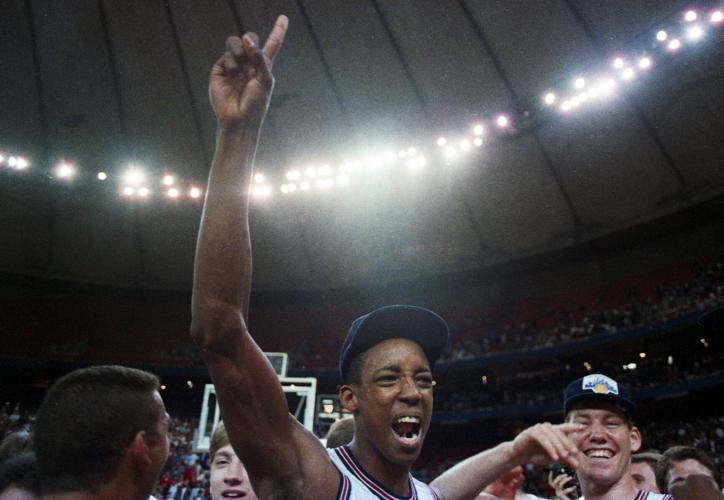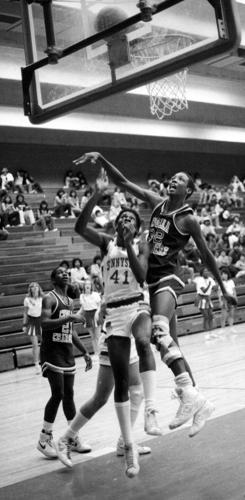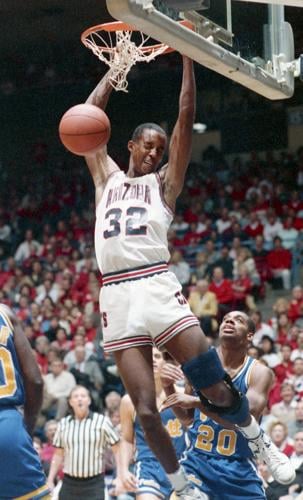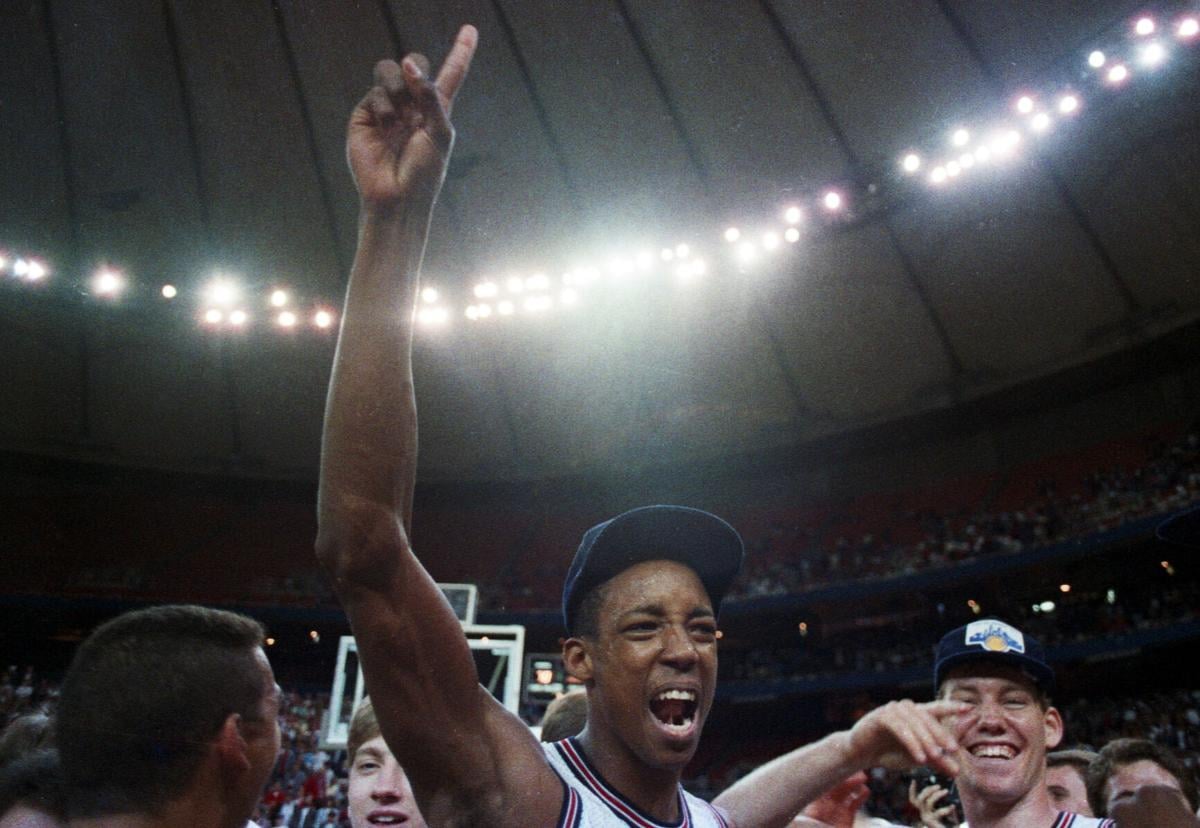Late in the 1984 NBA season, rookie of the year Ralph Sampson flew to Tucson to complete a business deal and spend part of the afternoon playing basketball at the Tucson Athletic Club.
Once Cholla High School junior Sean Elliott found out about Sampson’s appearance, he, too, went to the gym, basketball in hand, and began taking jump shots on the opposite end of the court.
One of Elliott’s jumpers bounced off the rim and rolled to Sampson, who picked it up and tossed it back to the awestruck Elliott. When asked about the encounter with the John Wooden Award winner and Adolph Rupp Player of the Year, Elliott said: “It was amazing; he even touched my basketball.”

Five years later, Elliott was the John Wooden Award winner and Adolph Rupp Player of the Year.
That summer, the under-the-radar Cholla Charger emerged as an elite prospect, becoming an all-star at the three biggest summer camps of the 1980s: the Five-Star Camp in Pennsylvania, the B/C Camp in Indiana and the Super Star Camp in Santa Barbara.
Ranked No. 3 on our list of Tucson’s Top 100 Sports Figures of the last 100 years, Elliott couldn’t have had better timing. Or maybe it’s that Arizona coach Lute Olson’s couldn’t have had better timing. On Sept. 4, 1984, Elliott made a commitment to play for the Wildcats.
The Wildcats were a year removed from a 4-24 season. Olson was about to begin his second UA season; the Wildcats were picked to finish eighth in the Pac-10.
On Jan. 3, 1985, Olson drove to Sahuaro High School to watch Elliott and the Chargers play against Arizona prep powerhouse Sahuaro, coached by two-time state champion Dick McConnell. Elliott scored a school-record 48 points.
“He’s a future All-American,” said McConnell. “He’s the best (Tucson) player I’ve ever seen. It was the most outstanding performance I’ve ever seen.”

Sean Elliott dunks against Pitt during the 1989 Fiesta Bowl Classic at McKale Center.
With Elliott, a freshman, in the UA lineup in 1986, the Wildcats won their first Pac-10 championship, clinching the historic victory at Pauley Pavilion. John Wooden sat behind the UCLA bench that night. Elliott scored 28 points.
It was not the last time Elliott would break UCLA’s basketball heart. On an unforgettable February afternoon at McKale Center, 1989, Elliott scored 35 points to break the Pac-10’s career scoring record held by Kareem-Abdul Jabbar. Bruins coach Jim Harrick said “Where do you get a player like Sean Elliott? I want one.”
Olson added: “Sean’s the best big-game player I’ve ever seen.”
Elliott’s jersey No. 32 was retired at McKale Center in 1996, a game in which his 1988 Final Four teammates Steve Kerr, Jud Buechler and Sean Rooks flew to Tucson for the game.
It might be that the greatest game of Elliott’s storybook-type career came on March 14, 2000, at the Alamodome in San Antonio.
Six months after undergoing a kidney transplant, Elliott, then 32, had worked his way back to health. The man whose “Memorial Day Miracle” 3-pointer had led the San Antonio franchise to its first NBA championship a year earlier chose not to retire. He would become the first pro athlete to return to competition after a major organ transplant.
The Alamodome was abuzz that night. Normal capacity for a regular-season game was 20,000, but the Spurs admitted 26,807 fans that night. Many high-profile Tucsonans flew to Texas for the game, including auto dealer Jim Click, attorney Burt Kinerk, Judge Michael Brown and about 30 of Elliott’s family members, including his mother, Odiemae, a critical care nurse who had raised three boys as a single mother.
Early in the third quarter, Elliott drove into the paint and dunked over several Atlanta Hawks, including former Wildcat All-American Jason Terry.
The crowd stood and cheered so loudly, and for so long, that the game was stopped. Elliott was taken out of the game.

Cholla High School's Sean Elliott (32) battles the boards against Sunnyside.
“Sean showed me more guts than I thought people had,” Terry told me that night in San Antonio. “He looked pretty good with that dunk, didn’t he?”
Elliott was a gifted student at Tolson Elementary School, and an even better athlete. He was a Little League baseball all-star who set a state age-group record in the long jump. He was the MVP of his youth soccer team.
But at 13, growing to near 6 feet tall, Elliott was in the Cholla High School gymnasium one afternoon when he was greeted by Chargers basketball coach Mel Karrle.
“He told me his best sport was soccer,” Karrle said. “But once I got a look at his body — he had very long arms — I said, ‘Sean, you should consider playing basketball.’”

Sean Elliott became a San Antonio Spurs legend, and the NBA franchise retired his No. 32 jersey.
He went on to score 10,544 points in the NBA and play in two All-Star Games. The Spurs retired his jersey, No. 32, in 2005. In 2018, Elliott was inducted into the College Basketball Hall of Fame. After working for ESPN and Fox Sports, Elliott is now the Spurs’ radio and TV analyst.
Photos: Arizona Wildcats vs. Oklahoma in 1988 NCAA Final Four
Arizona vs. Oklahoma / 1988 NCAA Final Four
Updated
Arizona's Sean Elliott shoots a jumper during the NCAA Final Four semi-final against Oklahoma on April 2, 1988, in Kansas City, Mo.
Arizona vs. Oklahoma / 1988 NCAA Final Four
Updated
Arizona guard Steve Kerr dutifully signs autographs prior to the NCAA Final Four semi-final against Oklahoma on April 2, 1988, in Kansas City, Mo.
Arizona vs. Oklahoma / 1988 NCAA Final Four
Updated
Arizona basketball coach Lute Olson eschews autograph seekers prior to the NCAA Final Four semi-final against Oklahoma on April 2, 1988, in Kansas City, Mo.
Arizona vs. Oklahoma / 1988 NCAA Final Four
Updated
Arizona basketball coach Lute Olson during open practice prior to the NCAA Final Four semi-final against Oklahoma on April 2, 1988, in Kansas City, Mo.
Arizona vs. Oklahoma / 1988 NCAA Final Four
Updated
Arizona's Anthony Cook, left, and Harvey Mason during open practice prior to the NCAA Final Four semi-final against Oklahoma on April 2, 1988, in Kansas City, Mo.
Arizona vs. Oklahoma / 1988 NCAA Final Four
Updated
Arizona head basketball coach Lute Olson during open practice before the NCAA Final Four semi-final against Oklahoma on April 2, 1988, in Kansas City, Mo.
Arizona vs. Oklahoma / 1988 NCAA Final Four
Updated
Arizona's Sean Elliott drives during the NCAA Final Four semi-final against Oklahoma on April 2, 1988, in Kansas City, Mo.
Arizona vs. Oklahoma / 1988 NCAA Final Four
Updated
Arizona's Anthony Cook shoots a jumper during the NCAA Final Four semi-final against Oklahoma on April 2, 1988, in Kansas City, Mo.
Arizona vs. Oklahoma / 1988 NCAA Final Four
Updated
Arizona forward Jud Buechler reacts during the NCAA Final Four semi-final against Oklahoma on April 2, 1988, in Kansas City, Mo.
Arizona vs. Oklahoma / 1988 NCAA Final Four
Updated
Oklahoma's Dave Sieger reaches for the ball as Arizona's Joe Turner falls to the ground during the first half of their NCAA final four tournament semifinal game in Kansas City, Saturday, April 2, 1988.
Arizona vs. Oklahoma / 1988 NCAA Final Four
Updated
Arizona's Steve Kerr reaches for the ball as Oklahoma's Mookie Blaylock (10) presses from behind during the first half of their semifinal game at the final four tournament in Kansas City, Saturday, April 2, 1988.
Arizona vs. Oklahoma / 1988 NCAA Final Four
Updated
Arizona guard Steve Kerr looks for an outlet during the NCAA Final Four semi-final against Oklahoma on April 2, 1988, in Kansas City, Mo.
Arizona vs. Oklahoma / 1988 NCAA Final Four
Updated
Arizona's Sean Elliott shoots a jumper during the NCAA Final Four semi-final against Oklahoma on April 2, 1988, in Kansas City, Mo.
Arizona vs. Oklahoma / 1988 NCAA Final Four
Updated
The Arizona bench watches the clock tick down during the NCAA Final Four semi-final against Oklahoma on April 2, 1988, in Kansas City, Mo.
Arizona vs. Oklahoma / 1988 NCAA Final Four
Updated
Sean Elliott of Arizona, left, fights for a rebound during the NCAA Final Four semi-final against Oklahoma on April 2, 1988, in Kansas City, Mo.
Arizona vs. Oklahoma / 1988 NCAA Final Four
Updated
Arizona's Joe Turner battles for a rebound during the NCAA Final Four semi-final against Oklahoma on April 2, 1988, in Kansas City, Mo.
Arizona vs. Oklahoma / 1988 NCAA Final Four
Updated
Anthony Cook buries his head on Arizona's bench during the NCAA Final Four semi-final against Oklahoma on April 2, 1988, in Kansas City, Mo.







